West Oxfordshire
Explore hidden histories, historic photos, and things you never knew about West Oxfordshire from the collections and archives of Historic England.
Discover your local listed buildings and places
Introducing some of West Oxfordshire's most historic sites, included in the National Heritage List for England. Some of these captions have been summarised by AI. Click through for the official List entry. Skip this section and go to place by numbers
Heythrop Park
Enstone
Heythrop Park is an early 18th-century country house known for its formal gardens, lakes, avenue, and historical ties to notable figures like Charles Talbot, Duke of Shrewsbury.
The New House with surrounding pool and garden wall to th…
Shipton-under-Wychwood
A private house built in 1964 by Stout and Litchfield for Milton Grundy. Read the official list entry to find out more.
Sarsden House
Churchill
Sarsden House is a notable country house redesigned in the 17th century, surrounded by a landscape crafted by Humphry Repton in 1795.
Shipton Court
Shipton-under-Wychwood
Shipton Court, built in 1603, features gardens redesigned in the early 20th century by architects Perkins and Bulmer, showcasing fountains, ponds, and terraces amidst historical structures.
Eynsham Hall
Eynsham
Eynsham Hall, an Elizabethan-style country house rebuilt in the early 1900s, features extensive parkland, ornamental gardens, and historical ties to the Langford and Macclesfield families.
Blenheim Palace
Blenheim
Blenheim Palace, a Baroque country house, was built from 1706-29 for the Duke and Duchess of Marlborough, with carvings by Grinling Gibbons and interiors featuring works by Laguerre and...
Cornbury Park
Charlbury
Cornbury Park, a 16th and 17th-century country house, was frequently visited by English royalty and was involved in significant historical events.
The Japanese Garden at the New House
Shipton-under-Wychwood
A Japanese style garden, laid out in c1964-5 by a small team of gardeners from Japan led by Mr Kasamoto and the modern abstract painter Viacheslav Atroshenko (1935-1994), for Milton Grundy...
Blenheim Palace
Bladon
Blenheim Palace, near Oxford, is a magnificent 18th-century mansion and park, designed by John Vanbrugh and Henry Wise, with later contributions by Lancelot Brown and Achille Duchene.
Blenheim Palace
Bladon
The official listing for all World Heritage sites is held by UNESCO and can be found on their website.
Rousham
Lower Heyford
Rousham, a 17th-century country house in Oxfordshire, features landscaped pleasure grounds designed by Charles Bridgeman and William Kent, with strong cultural and historical significance.
Church of St John the Baptist
Burford
The Church of St John the Baptist, dating back to the 12th century, features a cruciform plan with a central tower and spire.
Kiddington Hall
Kiddington with Asterleigh
Kiddington Hall is a 17th-century Italianate house, remodeled in 1850 by Charles Barry, surrounded by a landscape park designed by Lancelot Brown in the 18th century.
Great Tew
Great Tew
Great Tew is a landscape park originating in the 17th century, notable for associations with Humphry Repton and John Claudius Loudon, and historical figures like Viscount Falkland.
Ditchley Park
Spelsbury
Ditchley Park, an early 18th-century country house, features gardens by John Claudius Loudon and Geoffrey Jellicoe. Winston Churchill visited during the 1940s.
The Great Kitchen Approximately 40 Metres South of Harcou…
Stanton Harcourt
The Great Kitchen, around 40 meters from Harcourt House, built circa 1485, is noted for its medieval design, conical roof, and impressive architectural features like trefoil-headed windows...
White Hart Hotel
Chipping Norton
The White Hart Hotel, a 16th-century timber structure, was remodeled in the 20th century in local Baroque style, featuring significant architectural elements and period interiors.
Chastleton Barrow camp: a hillfort south of Barrow House
Chastleton
Chastleton Barrow camp is a well-preserved slight univallate hillfort, significant for understanding Bronze to Iron Age transitions, featuring stone ramparts and archaeological potential.
Water Terrace Gardens, Bernini Fountain on West Terrace
Blenheim
The Bernini Fountain, a late 17th-century marble and limestone piece, depicts four river figures, gifted to the Duke of Marlborough in 1710, and restored in 1932.
Church of St Mary
Swinbrook and Widford
The Church of St Mary in Swinbrook has origins dating back to the 11th century with significant architectural additions over centuries, featuring historical monuments and medieval elements.
Cornbury House
Cornbury and Wychwood
Cornbury House, set in a deer park, was enlarged in 1632-3 by Nicholas Stone for Earl of Danby. Features include late 17th-century chapel interiors and classical architectural details.
Asthall Barrow: an Anglo-Saxon burial mound 100m SSW of B…
Asthall
Asthall Barrow is an Anglo-Saxon burial monument, depicting high-status markers constructed during pagan periods for figures with territorial significance.
Church of St Michael
Stanton Harcourt
Church of St. Michael features mid-12th-century origins, a 13th-century chancel screen, and significant monuments, including the Harcourt Chapel by William Orchard.
Grand Bridge
Blenheim
Designed by Sir John Vanbrugh around 1706-1712, Blenheim's Grand Bridge was intended as a habitable viaduct with over 30 rooms, featuring semi-circular arches and rusticated details.
High Lodge and Attached Walls
Blenheim
High Lodge, built around 1768 by Capability Brown, is a Gothick-style hunting lodge with crenellated parapets, pointed-arched windows, and enclosed yard walls.
Church of St Leonard
Eynsham
The Church of St Leonard features late 13th-century chancel and south aisle, with significant 15th-century additions. Notable for historical stained glass and reset brasses from 1610.
Aston War Memorial
Aston, Cote, Shifford and Chimney
First World War memorial of 1919, with names added after the Second World War. Read the official list entry to find out more.
Manor Farmhouse
Minster Lovell
Manor Farmhouse, with 12th-century origins and 15th-century elements, may have been a chapel in the Lovell family's manor. It features historical architecture and a ribbed 15th-century door.
North Leigh Roman villa 300m NNE of Upper Riding Farm
North Leigh
North Leigh Roman villa, a significant Romano-British site, exemplifies luxury with over 60 rooms, mosaics, and hypocaust heating, reflecting societal Romanisation and historical...
Ascott d'Oyley 12th century motte and bailey castle and a…
Ascott-under-Wychwood
Ascott d'Oyley is a 12th-century motte and bailey castle known for its strategic position and contribution to medieval village development, with remains indicating its historical...
Church of All Saints
Churchill
The Church of All Saints, built in 1826 by James Plowman, features a Perpendicular-style west tower based on Magdelen College, Oxford. It includes stained glass commemorating James Langston.
Manor House
Ascott-under-Wychwood
Manor House in Ascott-under-Wychwood, with 13th-century origins and Cotswold stone features, stands within the historic bailey of Ascott d'Oyley Castle.
Tackley Water Garden
Tackley
Tackley Water Garden, developed by John Harborne in the 17th century, is notable for its historical landscape design with formal water gardens, terraced structures, and an elaborate fishpond...
Church of St Mary
Steeple Barton
The Church of St Mary, built in the 14th and 15th centuries and restored in 1850, features historical architecture with stained glass and a fluted 12th-century font.
Church of St James the Great
Stonesfield
The Church of St. James the Great, primarily 13th-century with later modifications, showcases C14 and C15 architectural features and stained glass, reflecting its historical significance.
Langford War Memorial
Langford
First World War memorial of 1920 with further names added after the Second World War. Read the official list entry to find out more.
Explore more
Search for more listed placesWest Oxfordshire through time
This timeline shows the first period of use for buildings and places on the National Heritage List for England, just one of the details recorded for every list entry. Click around to see how West Oxfordshire changes over time. Skip this section and go to aerial photos
Prehistoric Before AD 43
Prehistory covers a million years of human occupation before the Roman invasion and the introduction of writing. Primarily hunter-gatherers of several human species including Neanderthals, the peoples moved across Europe, hunting animals, exchanging ideas and developing complex culture and belief systems including burial rites and astronomical understanding, as at Stonehenge for example.
Roman AD 43 to AD 410
Britain was invaded by four legions of the Roman army in AD 43, who relatively rapidly conquered England from landing points in Kent. Parts of Wales and Scotland soon followed.
Roman culture brought urbanism, monumental buildings, wide-ranging religious beliefs, writing, and strong social hierarchy. The Roman administrative system was withdrawn in AD 410.
Early medieval AD 410 to AD 1066
This period, often associated in England with Anglo-Saxons and Vikings, saw a reduction in urban living from the Roman period and increased migration from northern Europe.
Traces of this period can be found in cemeteries, particularly in artefacts and in some of the very early churches, as this period also saw the growth of Christianity in Britain.
Medieval AD 1066 to AD 1540
This period, sometimes known as the Middle Ages, began with the Norman invasion in AD 1066. It saw a significant rise in military and defensive buildings such as castles and earthworks, as well as religious houses dominating a largely agricultural landscape.
The monarchy and Church dominated the period, which also saw the break with the Roman Catholic Church and the English reformation.
Post medieval AD 1540 to AD 1901
The Post-Medieval period brought seismic changes to life in England, with religious reformation leading to the democratization of worship and the destruction of hundreds of religious houses.
In parallel, there was a huge expansion of scientific study and enlightenment that permanently altered the nation's social structure and landscape. Industrialization and mass production lead to wider global trade, emigration, and immigration.
20th century AD 1901 to AD 2000
The 20th century saw an incredible expansion of England's transport networks, with suburban growth shadowing rapid infrastructural expansion. The establishment of state schools, hospitals, and modern technical colleges, with new architectural styles, radically changed the appearance of towns and cities.
Two catastrophic world wars and the 1918 pandemic also brought unprecedented change, altering England's built environment and social structures forever.
Prehistoric Before AD 43
Prehistory covers a million years of human occupation before the Roman invasion and the introduction of writing. Primarily hunter-gatherers of several human species including Neanderthals, the peoples moved across Europe, hunting animals, exchanging ideas and developing complex culture and belief systems including burial rites and astronomical understanding, as at Stonehenge for example.
Roman AD 43 to AD 410
Britain was invaded by four legions of the Roman army in AD 43, who relatively rapidly conquered England from landing points in Kent. Parts of Wales and Scotland soon followed.
Roman culture brought urbanism, monumental buildings, wide-ranging religious beliefs, writing, and strong social hierarchy. The Roman administrative system was withdrawn in AD 410.
Early medieval AD 410 to AD 1066
This period, often associated in England with Anglo-Saxons and Vikings, saw a reduction in urban living from the Roman period and increased migration from northern Europe.
Traces of this period can be found in cemeteries, particularly in artefacts and in some of the very early churches, as this period also saw the growth of Christianity in Britain.
Medieval AD 1066 to AD 1540
This period, sometimes known as the Middle Ages, began with the Norman invasion in AD 1066. It saw a significant rise in military and defensive buildings such as castles and earthworks, as well as religious houses dominating a largely agricultural landscape.
The monarchy and Church dominated the period, which also saw the break with the Roman Catholic Church and the English reformation.
Post medieval AD 1540 to AD 1901
The Post-Medieval period brought seismic changes to life in England, with religious reformation leading to the democratization of worship and the destruction of hundreds of religious houses.
In parallel, there was a huge expansion of scientific study and enlightenment that permanently altered the nation's social structure and landscape. Industrialization and mass production lead to wider global trade, emigration, and immigration.
20th century AD 1901 to AD 2000
The 20th century saw an incredible expansion of England's transport networks, with suburban growth shadowing rapid infrastructural expansion. The establishment of state schools, hospitals, and modern technical colleges, with new architectural styles, radically changed the appearance of towns and cities.
Two catastrophic world wars and the 1918 pandemic also brought unprecedented change, altering England's built environment and social structures forever.
Aerial photos of West Oxfordshire
Aerial photography helps reveal secrets of England's changing landscapes that are impossible to see from the ground. Skip this section and go to archive images
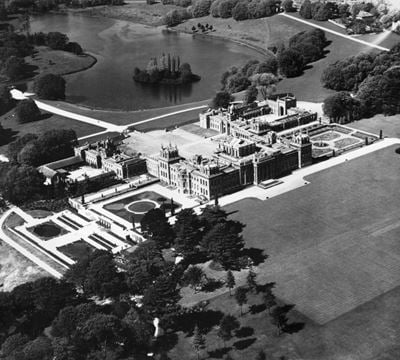
Woodstock
Blenheim Palace, Woodstock, 1929

Woodstock
Blenheim Palace, Woodstock, 1953

Woodstock
The town centre, Woodstock, 1929
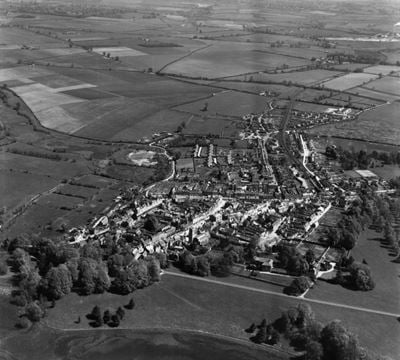
Woodstock
The village, Woodstock, 1948
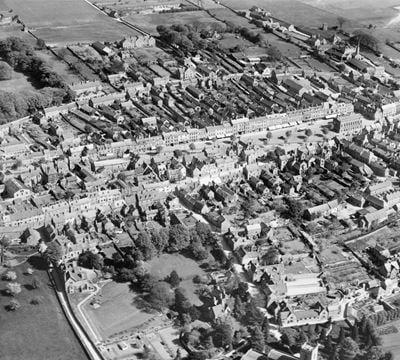
Chipping Norton
The town centre, Chipping Norton, 1929

Chipping Norton
The town centre, Chipping Norton, 1972

Witney
Bridge Street, Witney, 1928
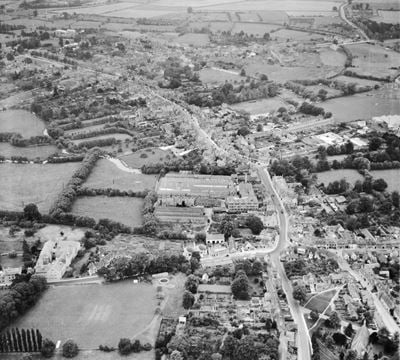
Witney
The Steam Works and town centre, Witney, 1946

Shilton
The village, Shilton, 1949
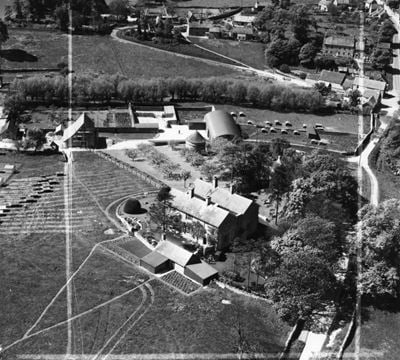
Shilton
The Manor, Shilton, 1949
West Oxfordshire in the Historic England Archive
The Historic England Archive cares for over 15 million images, dating from the 1850s to the present day. Discover stunning images of West Oxfordshire's past. Skip this section and go to stories about heritage
Eric de Mare
Kelmscott, West Oxfordshire, Oxfordshire
Date created: 1945 - 1980
Interior detail view of the dovecote at Kelmscott Manor.
John Gay Collection: Counties
West Oxfordshire, Oxfordshire
Date created: 1973
A lamp hanging in the timber framed carriage way of The Bull Hotel
John Laing Collection
Blenheim, West Oxfordshire, Oxfordshire
Date created: 30 Jun 1993
Four members of Laing's Midlands Senior Citizens Club posed beside a cannon during a visit to Blenheim Palace
Alfred Newton and Sons
Little Rollright, West Oxfordshire, Oxfordshire
Date created: 16 May 1908
EXTERIOR FROM SOUTH WEST
Walter Scott
West Oxfordshire, Oxfordshire
Date created: 1950 - 1970
St Mary's Church, viewed from the south-east
Eric de Mare
Vale Of White Horse, Oxfordshire
Date created: 1949
A view showing the 14th century Old Radcot Bridge crossing the River Thames
John Gay Collection: Counties
West Oxfordshire, Oxfordshire
Date created: 1970
A view of woodland near Minster Lovell
John Laing Collection
Blenheim, West Oxfordshire, Oxfordshire
Date created: 01 Jul 1993
A member of Laing's South West Senior Citizens Club playing the Grand Organ in the Long Library during a visit to Blenheim Palace
Alfred Newton and Sons
Little Rollright, West Oxfordshire, Oxfordshire
Date created: 16 May 1908
GENERAL VIEW FROM GARDEN
Eric de Mare
Vale Of White Horse, Oxfordshire
Date created: 1949
A view showing the 14th century Old Radcot Bridge crossing the River Thames
John Gay Collection: Counties
West Oxfordshire, Oxfordshire
Date created: 1970
A finger post road sign with a sunflower plant towering above, probably at the road junction beside Bridge Cottage near Minster Lovell Bridge
John Laing Collection
Blenheim, West Oxfordshire, Oxfordshire
Date created: 01 Jul 1993
A member of Laing's South West Senior Citizens Club seated at the Grand Organ in the Long Library during a visit to Blenheim Palace
Stories about heritage in your local area
Historic England publishes news, blogs, research, videos, and podcasts celebrating England's rich heritage. Discover the stories we have about West Oxfordshire. Skip this section and go to education
The History of Ukrainians in England
Mentions The New House with surrounding pool and garden wall to the west, The Japanese Garden at the New House
Ukrainians have influenced several sites across England. Here is a small selection.
7 Unusual War Memorials
Mentions First World War memorial to the Price brothers, Westwell
The aftermath of the First World War saw a wave of public commemoration, sometimes in the form of quite unusual war memorials.
Travelling Through History with Doctor Who
Mentions The Rollright Stones
Between battling Daleks and dodging the Cybermen, the Doctor has taken us across the universe, and even dropped by some of England’s important...
Golden Touch: 6 Buildings that deserve an Oscar
Mentions Blenheim Palace
Over the years, English architecture has been the backdrop to many major productions.
6 Places that Inspired Alice in Wonderland
Mentions Folly Bridge
Published in 1856, the surreal world of Wonderland has captured imagination everywhere.
War Memorials Listed Ahead of Armistice Day
Mentions Cassington War Memorial
First World War memorials in England have been listed ahead of Armistice Day. Many of them also commemorate those lost during the Second World War.
Heritage at Risk 2018
Mentions Asthall Barrow: an Anglo-Saxon burial mound 100m SSW of Barrow Farm
Historic England unveils latest chapter in the fight to save important heritage in 20th year of the national Register.
Hot Dry Summer Reveals Hidden Archaeological Sites in England
Mentions Sites discovered by aerial photography, near Foxley Farm
Mysterious Neolithic ceremonial monuments, Iron Age settlements, square barrows and Roman farm discovered by Historic England’s flying archaeologists.
Public Call-out Uncovers England’s Secret and Unknown Memorials
Mentions Delly End Peace Memorial
Hundreds of nominations received as public share their knowledge of local monuments, street shrines and community tributes.
West Oxfordshire's social history through photos
Over 10,000 images from the Historic England Archive have been specially selected and re-captioned for teachers, students, and anyone who wants to learn more about their local area. Skip this section and go to grant-aided places
Witney Mill, Witney, Oxfordshire
Period: Georgian (1714 - 1836)
This mill dates to c1820. The mill was water powered. It combined the fulling, weaving and spinning processes under one roof.
Witney Mill, Witney, Oxfordshire
William Smith Memorial, Churchill, Oxfordshire
Period: Victorian (1837 - 1901)
This monument has the inscription "In memory of William Smith, the Father of British Geology. Born at Churchill March 23, 1769.
William Smith Memorial, Churchill, Oxfordshire
Webbley Terrace, Woodstcok, Oxfordshire
Period: Stuart (1603 - 1713)
These houses were built in the early 1600s. By the 1800s Woodstock's main industry was glove making.
Warwick Almshouses, Burford, Oxfordshire
Period: Medieval (Middle Ages) (1066 - 1484)
These almshouses were founded in 1457 by Henry Bishop of Burford. They were built on land donated by Richard Neville, Earl of Warwick.
Warwick Almshouses, Burford, Oxfordshire
Warren Hastings House, Churchill, Oxfordshire
Period: Stuart (1603 - 1713)
This house was built in the late 17th century and then remodelled in the early 18th century.
Warren Hastings House, Churchill, Oxfordshire
The Tolsey, Burford, Oxfordshire
Period: Tudor (1485 - 1602)
This building dates from the 16th century. It is first documented in 1561.
The Tolsey, Burford, Oxfordshire
The Stocks, Stanton Harcourt, Oxfordshire
Period: Medieval (Middle Ages) (1066 - 1484)
The village stocks with four ankle holes for the punishment of petty crime and misdemeanor in the village.
The Stocks, Stanton Harcourt, Oxfordshire
The Lamb Hotel, Burford, Oxfordshire
Period: Victorian (1837 - 1901)
People gathered in the street outside the hotel during the Hiring Fair (Mop Fair). A chalked sign reads 'Dinner 12.30'.
Discover more
Ready for more local heritage? Take a look at these other places nearby
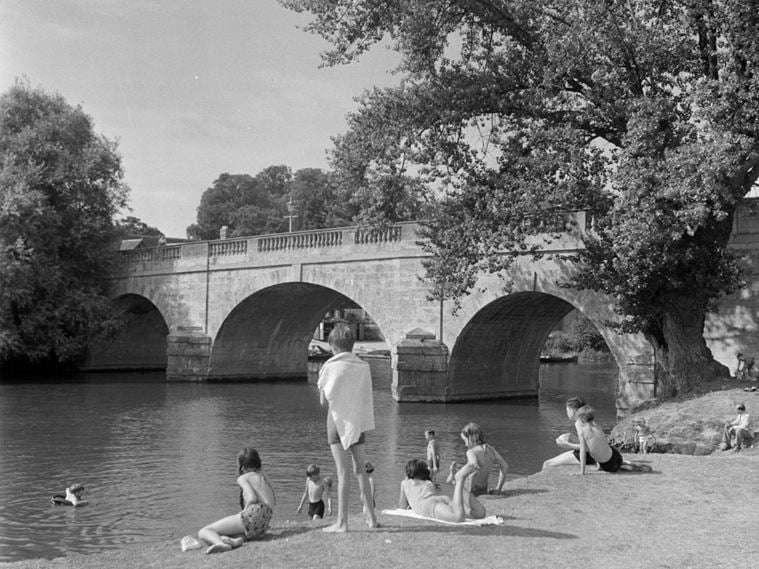
Oxfordshire
Ceremonial County

Cherwell
Local Authority District

Vale of White Horse
Local Authority District